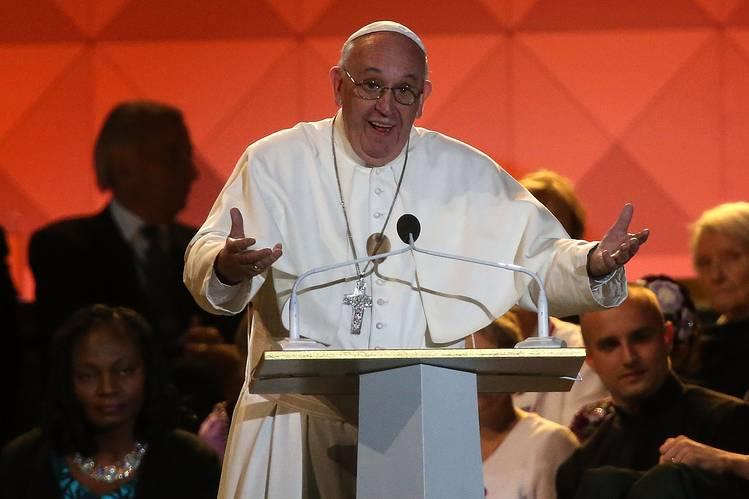|
How the Catholic Church Made a Social Media Splash During the Pope’s U.S. Visit
By Nathalie Tadena
When Bette Midler tweeted about Pope Francis’ historic visit to the U.S. last month and his respect for the environment, the U.S. Conference of Catholic Bishops tweeted back: “Not only does he respect the environment, he LOVES Beaches” referring to one of the actress’s well-known movies. The tweet was part of an expansive social media push from the USCCB, which represents the Catholic Church’s bishops in the U.S., to promote the pope’s message of goodwill to a broad audience, including to digital savvy young people. Pope Francis’ U.S. visit shed light on the state of the Catholic Church in the U.S., which suffered a 3.1% drop in its ranks to 20.8% of the U.S. population between 2007 and 2014, according to the Pew Research Center. The number of Americans who don’t identify with any religion has also been on the rise -- according to a Pew report released earlier this year, 35% of adults in the U.S. born between 1981 and 1996 identify as religiously unaffiliated, up 10 percentage points from 2007. Only 16% of millennials in the Pew study identified as Catholics. USCCB hired Golin, a public relations agency owned by Interpublic, to manage its presence across Facebook, Twitter and Instagram during the six-day papal visit, marking the first time the conference had worked with an agency on an online engagement strategy. “This is certainly a new area for the church and a place we felt we needed to be to reach those we weren’t able to reach before,” said James Rogers, USCCB’s chief communications officer. The campaign included outreach to 120 influencers, such as Ms. Midler, and 1,300 others on social media in both English and Spanish, as well as the creation of real-time videos, GIFs and other content. With the papal visit, USCCB wanted to shift from a “model of broadcast communication” to a more engaging dialogue in real time, Mr. Rogers said. By many metric, the digital push paid off. During the papal visit, Golin created 2,268 pieces of social content for USCCB in English and Spanish that received 18.5 million impressions from word-of-mouth and shares. Campaign hashtags #popeinUS and #papaenUSA had more than 5 billion impressions. Views for the campaign’s videos totaled 1.65 million. Overall, there were 73 billion mentions of the Pope on social media during his U.S. visit, according to data from Sysomos, with 8% of those mentions including USCCB’s campaign hashtags, content or reference to the organization. In comparison, this year’s Super Bowl garnered 66.5 billion impressions, according to Sysomos. USCCB’s campaign, however, isn’t all about numbers. “We built the entire strategy around a purpose of joyously moving people to merciful action,” said Mary Jo Behrman, executive director of digital marketing for Golin. “Ultimately we wanted to convert the inspiration around the pope to action in the Catholic Church and help the Catholic Church in the U.S. gain relevance through the inspiration of their leader.” Golin had a team of 11 content creators, designers, writers and editors that traveled with the papal entourage to New York, Philadelphia and Washington, DC, setting up temporary newsrooms in each city to monitor, translate and respond to real-time conversations and stories about the pope, in addition to 50 people in the agency’s Chicago headquarters to help monitor longer-term trends and outreach. USCCB also had about 30 volunteers who were assigned to help Golin’s traveling social response team, known as the “The Bridge.” The campaign required extensive research into what the pope was likely to talk about, topics that were most important and relevant to the Catholic Church and the U.S. as well as the official teachings of the church. Several pre-approved messages and content around key topics were planned ahead. Ms. Behrman said Golin had about 100 pieces of planned “broadcast content” such as prayers that could be recited at the beginning of the pope’s site visits or information on how to support prison efforts and rehabilitation for inmates ahead of the pope’s scheduled visit to a prison. “This pope always goes off script,” Ms. Behrman said. “Our planning in advance was so critical so we were ready to move on the fly.” The campaign also included 59 real-time videos highlighting the most important clips of the pope’s visit, from his stepping onto U.S. soil for the first time to an interview with a Little Sisters of the Poor nun who received a surprise visit from the pope. Most importantly, the campaign aimed to engage one-on-one with individuals. The campaign reached out to 1,300 people through Tweets and comments, asking them to share their experiences or what they pray for in their lives, with 75% of those individuals responding back. USCCB’s social media push helped paint the Catholic Church in a modern light, thanks in part to pop culture references sprinkled throughout the campaign. In response to a Mashable report that new iPhone shipments in New York and Philadelphia could be delayed because of the papal visit, Golin posted an animated piece of content on Twitter of a frustrated iPhone customer asking Siri about her phone’s arrival only to be greeted with the passage, “Love is patient, love is kind.” Stephen Colbert, a self-proclaimed fan of Pope Francis, even mentioned the campaign hashtag on an episode of the Late Show during the pope’s visit. Twitter also rolled out special emoji for the pope’s visit, including one that appeared with the hashtag #PopeinUS. “We wanted to be in the moment, be a part of the conversation with relevant and dynamic content,” Mr. Rogers said. “Our task now is to look at how best we can operationalize this.” Contact: nathalie.tadena@wsj.com
|
.
Any original material on these pages is copyright © BishopAccountability.org 2004. Reproduce freely with attribution.
